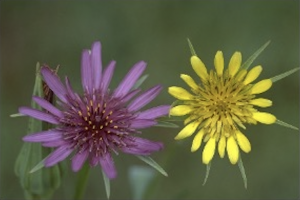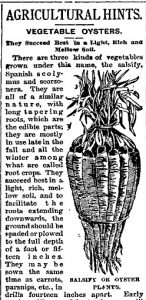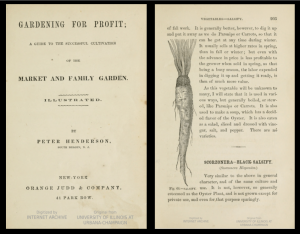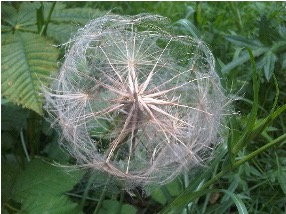by Kimberly Lerch | Published: May 20, 2020

While correcting text for the Illinois Digital Newspaper Collections (IDNC), I discovered an article in the June 15, 1918 issue of the Chicago Packer that covered a partial ban of some American produce into Canada. I believe the ban had more to do with World War I than the Spanish Influenza pandemic at the time, but I found it interesting that certain foods were banned while others were not.
The importation of certain fruits and vegetables considered essential for Canadian consumption will be permitted, with the following exceptions: Blackberries, gooseberries, currants, cucumbers, watermelons, artichokes, shallots, green peas, romaine, parsnips, salsify, pomegranates, quinces, nectarines, mangos, eggplant, green peppers, Brussels Sprouts, asparagus, mushrooms, parsley, endive, beets and turnips.[1]
Wait, what? I know what all those other things are, but what’s salsify? Is it used to make salsa? From context, I can assume it’s a fruit or vegetable. Time to Google…
Definition

Purple salsify (Tragopogon porrifolius), also called the oyster plant, vegetable oyster, or oat root, has a white root and purple flowers. Black salsify (Scorzonera hispanica), also known as Spanish salsify, has a black root and yellow flowers. Both types of salsify are in the Asteraceae family (along with dandelions) but are different species found naturally in western Eurasia.[2]
I will concentrate on the root and the young shoots of purple salsify, Tragopogon porrifolius, in this blog post.[3]
Okay, then; T. porrifolius, referred to as “salsify” from here on out, is a root vegetable in the same plant family as dandelions. Other root vegetables, such as turnips, parsnips, carrots, and beets were also banned temporarily from shipment to Canada.
Well, now that we know that it’s a root vegetable, let’s “dig” in!
The roots kind of look like carrots (see Fig. 2).[4] The young root is said to taste a bit asparagus-y, as does its stalk (usually not the part of the plant that is eaten,[5] but if you do decide to eat the stalk, prepare it like asparagus) and the grown root a bit oyster-y in flavor (hence the ‘oyster plant/vegetable oyster’ monikers).
History
In the United Kingdom salsify was grown for its flower head, not as food. In the 1700s, it was discovered that its roots were edible and even tasty![6] Salsify appeared in the Victorian classic Mrs Beeton’s Book of Household Management (1861).[7] Stored safely in Illinois Library’s Oak Street facility is the 1909 edition of “Mrs. Beeton’s Book of household management : guide to cookery in all branches, daily duties, mistress & servant, hostess & guest, marketing …” This newer edition was revised, enlarged, fully illustrated and brought up to date. Consisting of more than 2,000 pages, readers can also peruse this behemoth through its entry in the HathiTrust Digital Library.

Salsify was brought over to the New World with the colonists and was grown throughout New England and the Mid-Atlantic.[8] Peter Henderson, in his Gardening for Profit: A Guide to the Successful Cultivation of the Market and Family Garden (1867), from our ACES library and also available online via its entry in the HathiTrust Digital Library, states that although not many people eat it, it could “bring a high price” and would be a financially rewarding crop for those that farm it.

Currently, it’s $2.73 per can (per six-pack 14.1 ounce can unit); but even at that price (I guess Henderson was right—that’s kind of pricey for 14.1 ounces of canned veggies), it’s out of stock! I want to get some so that I can try some of the recipes in part two of this post: “Cooking with Salsify.” There are about four or so ways you can prepare salsify, so a six-pack should be enough to try each.
Most of the world’s salsify is imported from Belgium now. You can order salsify from Walmart!
Medicinal Use
Back in 1893, it was reported in the True Republican that “salsify … has been recommended as remedial or alleviating in cases of consumptive tendencies…”[9] Salsify is also considered by some to be a food that can help clear out the natural ducts of the fluids and secretions of the body (the liver and gallbladder), act as a diuretic, alleviate nausea, help with constipation, and treat jaundice, arteriosclerosis, and high blood pressure.[10],[11] The Farmer’s Voice, all the way back in 1900, boasted that it “…ranks even above the dandelion root in the excellence of its medicinal qualities…”[12]
Grow Your Own

As reported in the Urbana Daily Courier for home gardeners, “the heads of salsify open out as they ripen, and unless gathered, the seed will be blown away. It is necessary, therefore, to gather the opening heads about noon of every sunny day, and spread them in an airy place until dry, when the seed can be rubbed out, winnowed and stored.”[13] The head looks very similar to a puffy dandelion head when it’s ready to have its seeds blown away (see Fig. 5).
Growing your own salsify is pretty straightforward;[14] it’s very similar to growing carrots, beets, and other root vegetables:
- In the spring, prepare the soil for the salsify. Salsify grows best in light soil–that is, soil that has more sand than clay in it. Light soil does not hold moisture well which is just fine with the salsify roots. They prefer that!
- Light soils can also be light on nutrients; add some compost while preparing the soil.
- Plant the seeds about one inch deep in rows about one and one-half to two feet apart (assuming you’re going to grow that much!).
- As the seedlings come up and begin to crowd one another, thin out the plants to about 4 inches apart.
- It’s going to take about three months to get a harvest of salsify. Be patient!
- If you plant them early in the spring and a frost occurs, don’t worry. Salsify is frost tolerant and the bit of cold on them can intensity their flavor.
- You don’t have to dig all of them up before the winter. If you mulch them in well, they will live through the winter.
Don’t think that’s all there is to know about salsify. Next week’s blog post will include salsify recipes–fried, baked, saucy, and souped up!
Help with Text Correction
The newspapers in the Illinois Digital Newspaper Collections are searchable because of computer-generated text that underlies the page images. This computer-generated text is far from perfect! You can help improve the accuracy of keyword searches by correcting errors. Thanks to the hard work of volunteer text correctors, more than a million lines of text have been corrected so far.
Register to become a text corrector.
Learn more about how to help correct newspaper text.
Notes:
[1] “Restrictions on Certain Shipments into Canada.” Chicago Packer, 15 June 1918, p. 1.
[2] Bonsall, Will. “The Many Uses of Salsify.” The Maine Organic Farmer & Gardener, Winter 2013-2014, mofga.org/Publications/The-Maine-Organic-Farmer-Gardener/Winter-2013-2014/Salsify. Accessed 26 Apr. 2020.
[3] “Tragopogon porrifolius.” Wikipedia, 17 Apr. 2020, en.wikipedia.org/wiki/Tragopogon_porrifolius. Accessed 26 Apr. 2020.
[4] “Agricultural Hints.” True Republican [Sycamore, IL], 10 May 1893, p. 6.
[5] “Salsify and how to cook it.” The Farmers Voice [Chicago, IL], 24 Feb. 1900, p. 248.
[6] “Tragopogon porrifolius.” Wikipedia, 17 Apr. 2020, en.wikipedia.org/wiki/Tragopogon_porrifolius. Accessed 30 Apr. 2020.
[7] Monaghan, Angela. “Salsify: Waitrose brings back ‘forgotten’ Victorian vegetable.” The Guardian, 19 Nov 2018, theguardian.com/food/2018/nov/09/salsify-waitrose-forgotten-victorian-vegetable. Accessed 30 Apr. 2020.
[8] “The Salsify – A Little History and Some Growing Instructions.” Harvesting History, harvesting-history.com/the-salsify. Accessed 3 May 2020.
[9] “Agricultural Hints.” True Republican [Sycamore, IL], 10 May 1893, p. 6.
[10] “Salsify: Tragopogon porrifolius.” Medicinal Herbs, naturalmedicinalherbs.net/herbs/t/tragopogon-porrifolius=salsify.php. Accessed 30 Apr. 2020.
[11] “Salsafy.” Botanical.com, botanical.com/botanical/mgmh/s/salsaf08.html. Accessed 30 Apr. 2020.
[12] “Salsify and how to cook it.” The Farmers Voice [Chicago, IL], 24 Feb. 1900 p. 248.
[13] “Roots Left Out All Winter.” The Urbana Daily Courier, 23 Oct. 1922, p. 2.
[14] “The Salsify – A Little History and Some Growing Instructions.” Harvesting History, harvesting-history.com/the-salsify. Accessed 3 May 2020.